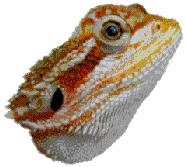 Food, diet
Food, diet| Home |
 Food, diet
Food, diet |
Our Photos | About Us | Contact Us |


What does a bearded dragon eat? While dragons of the wild are likely insect and seed eaters primarily, they benefit from a varied diet of dark,
leafy greens such as collards, kale, and mustard greens, etc. They also will eat hibiscus and dandelion flowers and
leaves (all of which are good for them), and finely chopped or grated vegetables. Do they eat insects and other bugs? Bearded dragons readily accept crickets (age-appropriate for them. See data, below), and they can make up the basis of the captive dragon's diet, with mealworms, wax worms and king mealworms for variety for lizards older than one month. Be sure your feeder insects are themselves well fed. "Gut-loading" your crickets (allowing the crickets to eat afore-said dark green leaft items and veggies), will suppliment your dragon's overall diet. And it's a great way to induce 'finicky eaters' to eat their greens. If the coveted bugs taste like greens, -the dragon will be more likely to actually eat their vegetables when offered, sans the bugs... Crickets that are 'too large' to be safely ingested might cause an impaction, which is serious. Bearded dragons can and will swallow things that are bigger than their relatively small throats can handle. The large mass then impinges upon nerve endings in the roof of mouth and along the lining of the throat, and this can cause moderate seizures ("ataxia") whose neurological symptoms include thrashing about, gaping, rapid movements of body and limb, head-or-neck twisting as if staring at the sky (very common symptom), and 'shovel-nosing' their substrate. Usually, the syptoms go away on their own. Stress makes the symtpoms WORSE. So, avoid handling and cuddling the dragon if they manifest these symptoms. If the dragons will drink, this gives some relief. As might covering the cage with a towel or blanket. Probably the darkness calms the ailing lizard and reduces their immediate stress, and this probably is the biggest factor to relieve their suffering until the obstruction has passed or softened. Do they eat meat? Adult dragons may receive an occasional pinky mouse, especially beneficial for females after egg-laying. The 'quick
protein' will help her regain her body mass and strength. Pinkie mice should be dusted with calcium suppliment prior to
giving. If dragons are kept on sand, food items should either be introduced in a smooth-sided bowl, deep enough to keep the food items in, but shallow enough for the dragons to climb in and out, or the dragons can be placed in a separate container (e.g., plastic sweater box) for feeding. Feeding your dragon The following is a suggested feeding schedule based upon approximate age:
You can only be just so safe, but by avoiding this potential risk you might easily enjoy a very happy and healthy pet Australian Bearded Dragon for many years to come! |
Note: This is a totally fabricated web-site, for a classroom assignment. But it depicts authenticatable facts.
Some text and iamges were 'harvested' from internet sources and 'altered' to populate these pages. No infringement of copyrights intended nor should be inferred.